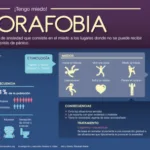
Agoraphobia, a term that conjures up images of confinement indoors, is one of the least understood but most debilitating mental health conditions out there. It is a disorder that is often hidden behind closed doors, the effects of which can be heartbreaking, profound and lasting for a long time. In recent years, it has become important to understand agoraphobia not as an isolated entity, but in relation to the traumatic events of those who suffer from it.
Agoraphobia manifests as a debilitating anxiety disorder, characterized by an overwhelming fear of specific situations or places, such as open spaces, crowds, or public places. Sufferers experience an intense feeling of vulnerability and anxiety, often triggered by the fear of not being able to escape or receive help in the event of a panic attack.
What makes agoraphobia even more intriguing is its close relationship with traumatic events. Many people with agoraphobia have experienced traumatic events in their lives, such as car accidents, violent events, abuse, or loss of loved ones. These events can trigger intense and persistent fear, leading to avoidance of situations or places that remind or relive the trauma.
In this article, we will define what agoraphobia is, understanding its most common and main symptoms and delving into understanding its relationship with traumatic events and events in the lives of the people who are affected.
What is agoraphobia?
Agoraphobia presents as an anxiety disorder characterized by an overwhelming fear of specific situations or places, such as open spaces, crowds, or public places. Sufferers experience an intense feeling of vulnerability and anxiety in these situations, often triggered by the fear of not being able to escape or receive help in the event of a panic attack. This paralyzing fear can lead to extreme avoidance of the feared circumstances, resulting in significant social isolation.
The symptoms of agoraphobia are varied and can affect each individual uniquely. Common symptoms include intense anxiety, irrational fear, palpitations, excessive sweating, tremors, shortness of breath, and feelings of loss of control. In more severe cases, panic episodes can trigger anxiety attacks that severely limit a person’s ability to lead a normal life.
The diagnosis of agoraphobia is based on the evaluation of a mental health professional, such as a psychologist or psychiatrist. Diagnostic criteria include the constant or recurrent presence of panic attacks or fear of specific situations, accompanied by active avoidance of those circumstances due to fear of an attack. The diagnostic process is essential to identify agoraphobia and distinguish it from other anxiety disorders or phobias.
Trauma and agoraphobia
Agoraphobia is not an isolated disorder, and its relationship to traumatic events is an area of growing research and concern in psychology and psychiatry. Agoraphobia is often rooted in traumatic experiences which can range from car accidents, violent events, loss of loved ones, to physical or psychological abuse. For many people, agoraphobia becomes a survival response to events that have caused them deep emotional stress.
Traumatic events can trigger the onset of agoraphobia symptoms by generating intense and persistent fear. People who have experienced trauma may develop an overwhelming fear of specific situations or places that remind them or cause them to relive the traumatic event. This can manifest itself in avoiding related areas, such as streets, buildings, or even social interactions that trigger those painful memories.
Scientific research has shown that traumatic events can have a lasting impact on the brain and nervous system, increasing vulnerability to anxiety disorders such as agoraphobia. The perception of danger is magnified, and the ability to cope with previously routine situations is seriously compromised.
Treatment and prevention
While this condition can be debilitating, there are effective treatment options and prevention strategies that offer hope. In this sense, the effectiveness of trauma-focused therapy stands out, whose strategies are designed to help modify the emotional consequences that the traumatic event leaves in memory. If you are looking for this type of services, contact us; At Psicomaster we will help you.
Treatment for agoraphobia should involve deep trauma-focused therapy such as EMDR alone or in combination with cognitive behavioral therapy, where individuals learn to manage their fears and develop skills to face feared situations in a gradual and controlled manner. Medication, such as antidepressants and anti-anxiety medications, may also be prescribed by mental health professionals to relieve symptoms. The combination of therapy and medication has proven to be effective in many cases.
When it comes to prevention, education and awareness play a crucial role. Identifying and addressing traumatic events early, offering emotional support and access to professional help can reduce the risk of agoraphobia developing or worsening. Furthermore, promoting safe and supportive environments in society may contribute to the prevention of agoraphobia by reducing the incidence of traumatic events. Research and ongoing support are essential to help those suffering from agoraphobia and to prevent its development in those who have experienced trauma.
The relationship between agoraphobia and traumatic events is a deep and complex connection that affects the lives of many people. Through this article, we have explored the symptoms, diagnosis, and the importance of understanding how trauma can trigger agoraphobia.








